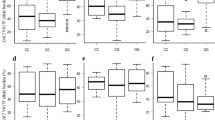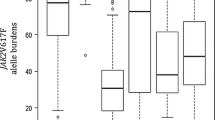Abstract
An association has been reported between a specific haplotype of the JAK2 gene, the homozygous 46/1 haplotype, and a predisposition to the development of chromosome Philadelphia-negative myeloproliferative neoplasms. Concerning myelofibrosis (MF), controversy remains on the relationship between the above JAK2 haplotype and the patients’ clinicohematological features and survival. Among 132 patients with MF (60 % primary MF, 20 % postpolycythemia vera MF, 20 % post-essential thrombocythemia MF; 59 % JAK2V617F positive) who were analyzed for the JAK2 46/1 haplotype, 29 were found to be homozygous and 53 heterozygous. The homozygous 46/1 haplotype was more often observed in JAK2V617F-positive patients (29.5 versus 11 %, p = 0.012). Moreover, among JAK2V617F-positive patients, those who were homozygous for the 46/1 haplotype had a higher allele burden than the remainder (92 versus 48 %, p = 0.0017). Overall, patients with homozygous 46/1 haplotype showed significantly higher hemoglobin values and higher leukocyte counts, but no association was seen with other clinicohematological features. Finally, no relationship was observed between the JAK2 46/1 haplotype and either the patients’ prognostic score or survival.

Similar content being viewed by others
References
Dameshek W (1951) Some speculations on the myeloproliferative syndromes. Blood 6:372–375
James C, Ugo V, Le Couédic JP et al (2005) A unique clonal JAK2 mutation leading to constitutive signaling causes polycythemia vera. Nature 434:1144–1148
Kralovics R, Passamonti F, Buser AS et al (2005) A gain-of-function mutation of JAK2 in myeloproliferative disorders. N Engl J Med 352:1779–1790
Levine RL, Wadleigh M, Cools J et al (2005) Activating mutation in the tyrosine kinase JAK2 in polycythemia vera, essential thrombocythemia and myeloid metaplasia with myelofibrosis. Cancer Cell 7:387–397
Baxter EJ, Scott LM, Campbell PJ et al (2005) Acquired mutation of the tyrosine kinase JAK2 in human myeloproliferative disorders. Lancet 365:1054–1061
Jones AV, Chase A, Silver RT et al (2009) JAK2 haplotype is a major risk factor for the development of myeloproliferrative neoplasms. Nat Genet 41:446–449
Olcaydu D, Harutyunyan A, Jäger R et al (2009) A common JAK2 haplotype confers susceptibility to myeloproliferative neoplasms. Nat Genet 41:450–454
Kilpivaara O, Mukherjee S, Schram AM et al (2009) A germline JAK2 SNP is associated with predisposition to the development of JAK2 (V617F)-positive myeloproliferative neoplasms. Nat Genet 41:455–459
Tefferi A, Lasho TL, Patnaik MM et al (2010) JAK2 germline genetic variation affects disease susceptibility in primary myelofibrosis regardless of V617F mutational status: nullizygosity for the JAK2 46/1 haplotype is associated with inferior survival. Leukemia 24:105–109
Wang J, Xu Z, Liu L et al (2013) JAK2V617F allele burden, JAK2 46/1 haplotype and clinical features of Chinese with myeloproliferative neoplasms. Leukemia 27:1763–1767
Guglielmelli P, Biamonte F, Spolverini A et al (2010) Frequency and clinical correlates of JAK2 46/1 (GGCC) haplotype in primary myelofibrosis. Leukemia 24:1533–1537
Tefferi A, Thiele J, Orazi A et al (2007) Proposals and rationale for revision of the World Health Organization diagnostic criteria for polycythemia vera, essential thrombocythemia, and primary myelofibrosis: Recommendations from an ad hoc international expert panel. Blood 110:1092–1097
Thiele J, Kvasnicka HM, Boeltken B, Zankovich R, Diehl V, Fischer R (1999) Initial (prefibrotic) stages of idiopathic (primary) myelofibrosis (IMF)—a clinicopathological study. Leukemia 13:1741–1748
Wilkins BS, Erber WN, Bareford D et al (2008) Bone marrow pathology in essential thrombocythemia: interobserver reliability and utility for identifying disease subtypes. Blood 111:60–70
Barosi G, Mesa RA, Thiele J et al (2008) Proposed criteria for the diagnosis of post-polycythemia vera and post-essential thrombocythemia myelofibrosis: a consensus statement from the International Working Group for Myelofibrosis Research and Treatment. Leukemia 22:438–439
Cervantes F, Dupriez B, Pereira A et al (2009) A new prognostic scoring system for primary myelofibrosis based on a study of the International Working Group for Myelofibrosis Research and Treatment. Blood 113:2895–3001
Wernig G, Mercher T, Okabe R et al (2006) Expression of Jak2V617F causes a polycythemia vera-like disease with associated myelofibrosis in a murine bone marrow transplant model. Blood 107:4274–4281
Kralovics R, Stockton DW, Prchal JT (2003) Clonal hematopoiesis in familial polycythemia vera suggests the involvement of multiple mutational events in the early pathogenesis of the disease. Blood 102:3793–3796
Bellanné-Chantelot Chaumarel I, Labopin M et al (2006) Genetic and clinical implications of the Val617Phe JAK2 mutation in 72 families with myeloproliferative disorders. Blood 108:346–352
Campbell PJ (2009) Somatic and germline genetics at the JAK2 locus. Nat Genet 41:385–386
Olcaydu D, Skoda RC, Looser R et al (2009) The ‘GGCC’ haplotype of JAK2 confers susceptibility to JAK2 exon 12 mutation-positive polycythemia vera. Leukemia 23:1924–1926
Pardanani A, Lasho TL, Finke CM et al (2010) The JAK2 46/1 haplotype confers susceptibility to essential thrombocythemia regardless of JAK2V617F mutational status—clinical correlates in a study of 226 consecutive patients. Leukemia 24:110–114
Jones AV, Campbell PJ, Beer PA et al (2010) The JAK2 46/1 haplotype predisposes to MPL-mutated myeloproliferative neoplasms. Blood 115:4517–4523
Patnaik MM, Lasho TL, Finke CM et al (2010) MPL mutation effect on JAK2 46/1 haplotype frequency in JAK2V617F-negative myeloproliferative neoplasms. Leukemia 24:859–860
Cervantes F, Dupriez B, Passamonti F et al (2012) Improving survival trends in primary myelofibrosis: an international study. J Clin Oncol 30:2981–2987
Passamonti F, Cervantes F, Vannucchi A et al (2010) A dynamic prognostic model to predict survival in primary myelofibrosis: a study by the International Working Group for Myeloproliferative Neoplasms Research and Treatment. Blood 115:1703–1708
Gangat N, Pardanani A, Hanson CA et al (2011) DIPSS-Plus: a refined dynamic international prognostic scoring system (DIPSS) for primary myelofibrosis that incorporates prognostic information from karyotype, platelet count and transfusion status. J Clin Oncol 29:392–397
Vannucchi AM, Lasho TL, Guglielmelli P et al (2013) Mutations and prognosis in primary myelofibrosis. Leukemia 27(9):1861–1869
Tefferi A, Lasho TL, Huang J et al (2008) Low JAK2V617F allele burden in primary myelofibrosis, compared to either a higher allele burden or unmutated status, is associated with inferior overall and leukemia-free survival. Leukemia 22:756–761
Guglielmelli P, Barosi G, Specchia G et al (2009) Identification of patients with poorer survival in primary myelofibrosis based on the burden of JAK2V617F mutated allele. Blood 114:1477–1483
Acknowledgments
This work has been supported in part by grants FIS PI10/00236 and RETICS RD12/0036/0010 and RD12/ 0036/0004 from the Instituto de Salud Carlos III, Spanish Ministry of Health.
Author information
Authors and Affiliations
Corresponding author
Rights and permissions
About this article
Cite this article
Martínez-Trillos, A., Maffioli, M., Colomer, D. et al. Relationship between the 46/1 haplotype of the JAK2 gene and the JAK2 mutational status and allele burden, the initial findings, and the survival of patients with myelofibrosis. Ann Hematol 93, 797–802 (2014). https://doi.org/10.1007/s00277-013-1989-5
Received:
Accepted:
Published:
Issue Date:
DOI: https://doi.org/10.1007/s00277-013-1989-5




